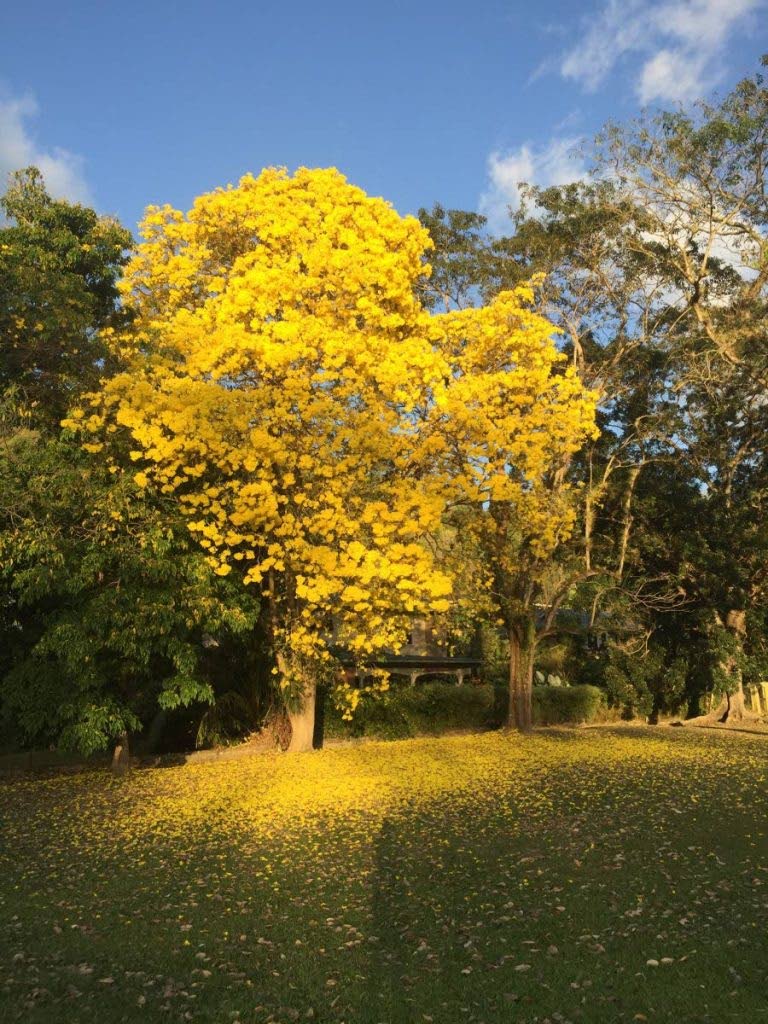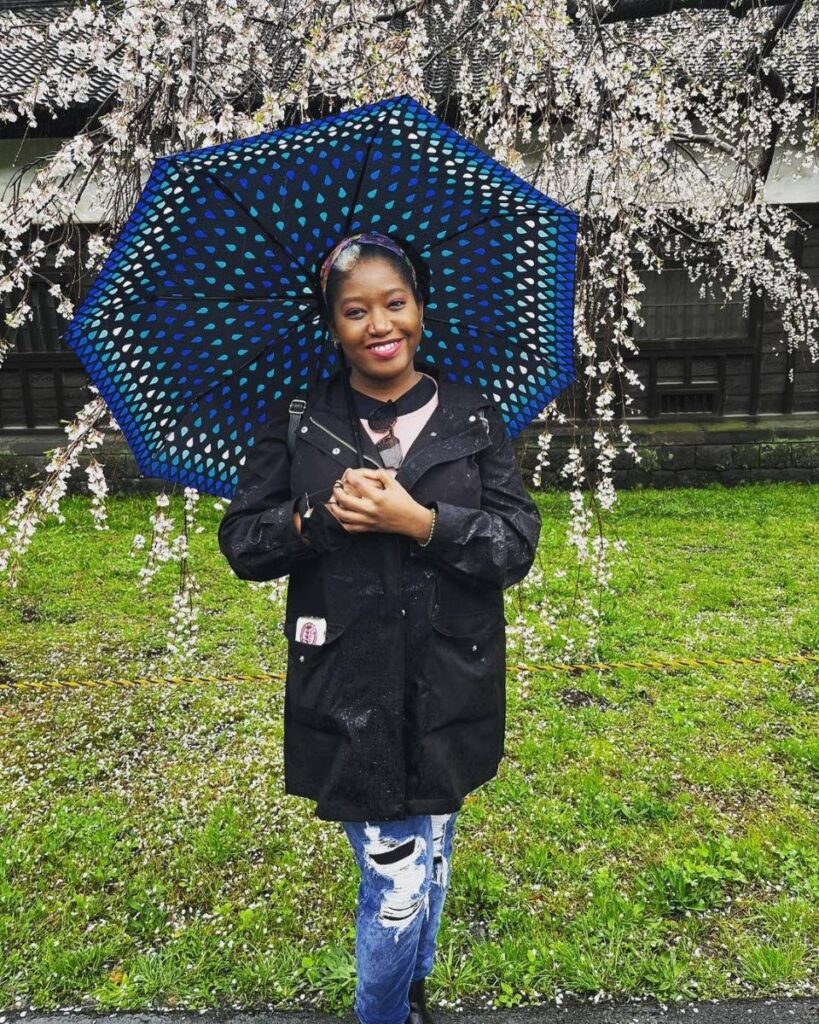Battle of the blossoms Sakura vs poui

When I was a child my parents would take my sister and me to the Queen’s Park Savannah on Sundays where we would run around barefoot in the grass. This, of course, was when parents were a little more nonchalant about things like ringworm infections and broken glass injuries.
My very first memory of poui trees is at the savannah where the display of trees that line the circular is arguably the most spectacular sight in the country. I’d lift a fistful of the fragrant flowers to my nose and inhale deeply before throwing them all over my little sister, who would immediately burst into a fit of laughter. We made a game of tossing the flowers back and forth at each other, sometimes even rolled around in them under the shade of a magnificent tree in the Hollows. There were times we were attacked by the bachacs whose nest we had disturbed.
As I grew older I made it a habit every time I was in Port of Spain to pass through Woodford Square during poui season just to get a whiff of the flowers of the tree that stands opposite the Hall of Justice. And while, for most islanders, the hibiscus flower is often seen as the flower that represents Trinidad and Tobago, I think the poui deserves a little more recognition as a national symbol.
I was introduced to cherry blossoms, or sakura as it is called in Japan, years before arriving in Japan in August of last year. I had been gifted a popular body mist in that fragrance. I became obsessed with it and was mortified when, on a trip to New York, it was confiscated by customs officers because I had forgotten the half-empty bottle in my carry-on. After getting to Japan, I waited in eager anticipation for the first signs of spring when I could finally inhale a fistful of sakura like I did as a child with my beloved poui petals. Sadly, brands that carry sakura-scented products have set a very unrealistic standard for foreigners. For while gorgeous to look at, the blossoms lack fragrance.
But what the sakura lacks in fragrance it makes up for in beauty. They are much shorter than poui trees and also come in two colour varieties: the more recognisable pale pink as well as white, which is a little less common and so even more special to see. If it’s one thing the Japanese do well is market their signature exports. Sakura season is big business here. Brands like KitKat sell sakura-themed goods, and cherry blossom festivals, called sakura matsuri, are held across the country in parks, near lakes and other public places where the sakura bloom. “Hanami,” which translates to “flower viewing,” are picnics held under the trees in sakura parks. Dating as far back as 1300 years ago, sakura season began in Japan’s Nara Prefecture which was the capital at the time. As one of the first signs of bloom, the trees mark the beginning of spring and warmer weather.

Due to an ill-timed flu I was not able to partake in this year’s hanami festivities, but I look forward to it next year. I was, however, able to tour the Tokyo Imperial Palace in Tokyo in the rain. The breathtaking views of the trees with the added backdrop of a sprawling castle, surrounded by a waterway with ducks waddling by was worth getting wet in the freezing cold (I think). While bigger parks may have more scenic viewings of the trees, I soon found out I don’t have to go out of my way to see them. The trees are everywhere. They line the roadways, in business parking lots, schools and, because they are small enough to be accommodated in most backyards, many people here have one in their yards.
While poui trees can start flowering as early as January and last into the month of May, full bloom in most places throughout the country coincides with the brief sakura season between late March to late April. Calendar with full bloom forecasts for each prefecture are issued in February of each year so the public is prepared for when and where they can see the flowers.
Because of the size of poui trees I understand that it may be difficult to plant large groves of them in the same way I’ve seen the sakura trees here. Poui trees can grow as tall as 150 feet and are considered one of the largest and strongest tropical forest trees, with a base as wide as seven feet in diameter. However, that has not stopped me from imagining the social and economic possibilities of a large poui forested area. Soca under de Trees or Poui or Pahtee both have a nice ring to them. For while, in my biased opinion, I believe the more popular and internationally recognisable sakura are a sight to behold, it pales in comparison to my native poui.
I am hardly the only Trini living in Japan, and it was interesting to hear from those who have been here far longer than I have how they feel about sakura season in Japan and how it compares to home. Kavita Premchan of San Francique has been living in Japan for ten years and resides in Oyabe City, Toyama Prefecture. She said the two seasons are quite similar and that there is definitely a market for more poui-season activities in TT.
“I think many people would enjoy chillin’ under the poui trees, hanging out with friends, and having a picnic. We need to have more parks filled with poui trees just for this. It would be incredible.”

But as much as she admires the beauty of poui trees, she still believes Japan’s sakura season is worth the hype.
“I have been living here for quite a number of years and I’m still blown away each year by the breathtaking beauty of the cherry blossoms. Seeing families and friends coming together and enjoying picnics under the cherry trees is my favourite thing.” She said her memories of poui season are not always the best, as it was always a reminder that exams were right around the corner. But she did enjoy walks around the Queen’s Park Savannah with her family when she was growing up.
Originally from St Augustine, Gabriella Bernard has been living in Osaka for three years. She said her prefecture is quite famous for its hanami activities, including parties, picnics in parks and near castles. There are also sakura-themed foods and drinks for patrons to enjoy at most restaurants. But she feels the season is overhyped for something that only lasts a few weeks.
“Compared to poui season dais small ting,” she said in her Trini dialect.
“We should definitely market poui season in a similar way, with our own Trini twist, of course. There is definitely a market for it because travel Instagram is a thing. Once something is Instagrammable people will go, even if it’s a terrible experience,” she said with a laugh, adding that scenic locations that make for good photo opportunities will always profit.
“My favourite part of poui season is when both the yellow and pink trees are in bloom within close range and mix together. It’s so pretty.”

Comments
"Battle of the blossoms Sakura vs poui"